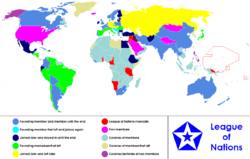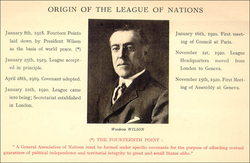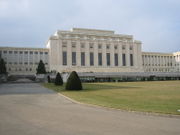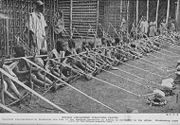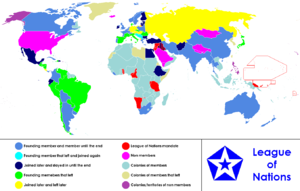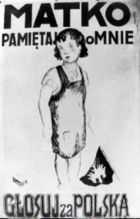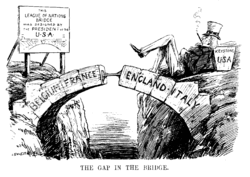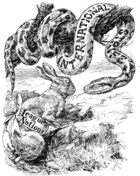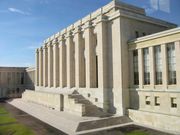League of Nations
2008/9 Schools Wikipedia Selection. Related subjects: Politics and government
|
|||||||||||||||||||||||||||||||||||||
The League of Nations was an international organization founded as a result of the Treaty of Versailles in 1919–1920. At its greatest extent from 28 September 1934 to the 23 February 1935, it had 58 members. The League's goals included disarmament, preventing war through collective security, settling disputes between countries through negotiation, diplomacy and improving global quality of life. The diplomatic philosophy behind the League represented a fundamental shift in thought from the preceding hundred years. The League lacked its own armed force and so depended on the Great Powers to enforce its resolutions, keep to economic sanctions which the League ordered, or provide an army, when needed, for the League to use. However, they were often reluctant to do so. Sanctions could also hurt the League members imposing the sanctions and given the pacifist attitude following World War I, countries were reluctant to take military action. Benito Mussolini stated that "The League is very well when sparrows shout, but no good at all when eagles fall out."
After a number of notable successes and some early failures in the 1920s, the League ultimately proved incapable of preventing aggression by the Axis Powers in the 1930s. The onset of the Second World War suggested that the League had failed in its primary purpose, which was to avoid any future world war. The United Nations replaced it after the end of the war and inherited a number of agencies and organizations founded by the League.
Origins
The concept of a peaceful community of nations had been outlined as far back as 1795, when Immanuel Kant’s Perpetual Peace: A Philosophical Sketch outlined the idea of a league of nations that would control conflict and promote peace between states. International co-operation to promote collective security originated in the Concert of Europe that developed after the Napoleonic War in the nineteenth century in an attempt to maintain the status quo between European states and so avoid war. This period also saw the development of international law with the first Geneva conventions establishing laws about humanitarian relief during war and the international Hague Conventions of 1899 and 1907 governing rules of war and the peaceful settlement of international disputes. The forerunner of the League of Nations, the Inter-Parliamentary Union (IPU), was formed by peace activists William Randal Cremer and Frederic Passy in 1889. The organization was international in scope with a third of the members of parliament, in the 24 countries with parliaments, serving as members of the IPU by 1914. Its aims were to encourage governments to solve international disputes by peaceful means and arbitration and annual conferences were held to help governments refine the process of international arbitration. The IPU's structure consisted of a Council headed by a President which would later be reflected in the structure of the League.
At the start of the twentieth century two power blocks emerged through alliances between the European Great Powers. It was these alliances that came into affect at the start of the First World War in 1914, drawing all the major European powers into the war. This was the first major war between industrialized countries and the first time the results of industrialization (for example mass production) has been dedicated to war. The result of this industrial warfare was an unprecedented casualty level with eight and a half million members of armed services dead, an estimated, 21 million wounded and approximately 10 million civilian deaths. By the time the fighting ended in November 1918, the war had had a profound impact, affecting the social, political and economic systems of Europe and inflicting psychological and physical damage on the continent. Anti-war sentiment rose across the world, the First World War was described as "the war to end all wars", and its possible causes were vigorously investigated. The causes identified included arms races, alliances, secret diplomacy and the freedom of sovereign states to enter into war for their own benefit. The perceived remedies to these were seen as the creation of an international organisation whose aim was to prevent future war through disarmament, open diplomacy, international co-operation, restrictions on the right to wage wars and penalties that made war unattractive to nations.
While the First World War was still underway, a number of governments and groups had already started developing plans to change the way international relations were carried out in order to prevent a repetition of the war. The idea for the League of Nations itself appears to have originated with the British Foreign Secretary Edward Grey. United States President Woodrow Wilson and his advisor Colonel Edward M. House enthusiastically adopted the idea as a means of avoiding any repetition of the bloodshed seen in World War I. The creation of the League's was a centerpiece of Wilson's Fourteen Points for Peace, specifically the final point: "A general association of nations must be formed under specific covenants for the purpose of affording mutual guarantees of political independence and territorial integrity to great and small states alike."
The Paris Peace Conference, that sought a lasting peace after World War I, approved the proposal to create the League of Nations (French: Société des Nations, German: Völkerbund) on 25 January 1919. The Covenant of the League of Nations was drafted by a special commission, and the League was established by Part I of the Treaty of Versailles. On 28 June 1919, the Covenant was signed by 44 states, including 31 states which had taken part in the war on the side of the Triple Entente or joined it during the conflict. Despite Wilson's efforts to establish and promote the League, for which he was awarded the Nobel Peace Prize in 1919, the United States did not join the League. Opposition in the U.S. Senate, particularly from Republicans politicians Henry Cabot Lodge and William E. Borah, together with Wilson's refusal to compromise, ensured that the United States would not ratify the Covenant.
The League held its first council meeting in Paris on 16 January 1920, six days after the Versailles Treaty came into force. In November, the headquarters of the League moved to Geneva, where the first General Assembly was held on 15 November 1920 with representatives from 41 nations in attendance.
Languages and symbols
The official languages of the League of Nations were French, English and Spanish (from 1920). The League seriously considered adopting Esperanto as their working language and actively encouraging its use but neither option was ever adopted. In 1921, there was a proposal by Lord Robert Cecil to introduce Esperanto into state schools of member nations and a report was commissioned to investigate this. When the report was presented two years later it recommended the teaching of Esperanto in schools, a proposal that 11 delegates accepted. The strongest opposition came from the French delegate, Gabriel Hanotaux, partially in order to protect the French Language which he argued was already the international language. This opposition meant the report was accepted apart from the section that approved Esperanto in schools.
The League of Nations had neither an official flag nor logo. Proposals for adopting an official symbol were made during the League's beginning in 1920, but the member states never reached agreement. However, League of Nations organizations used varying logos and flags (or none at all) in their own operations. An international contest was held in 1929 to find a design, which again failed to produce a symbol. One of the reasons for this failure may have been the fear by the member states that the power of the supranational organization might supersede their own. Finally, in 1939, a semi-official emblem emerged: two five-pointed stars within a blue pentagon. The pentagon and the five-pointed stars were supposed to symbolize the five continents and the five races of mankind. In a bow on top and at the bottom, the flag had the names in English (League of Nations) and French (Société des Nations). This flag was used on the building of the New York World's Fair in 1939 and 1940.
Principal organs
The League had four principal organs, a secretariat (headed by the General Secretary and based in Geneva), a Council, an Assembly and a Permanent Court of International Justice. The League also had numerous agencies and commissions. Authorization for any action required both a unanimous vote by the Council and a majority vote in the Assembly.
Secretariat and Assembly
The staff of the League's secretariat was responsible for preparing the agenda for the Council and Assembly and publishing reports of the meetings and other routine matters, effectively acting as the civil service for the League. The League of Nations' Assembly was a meeting of all the member states, with each state allowed up to three representatives and one vote. The Assembly met in Geneva and, after its initial sessions in 1920, sessions were held once a year in September.
Council
The League Council acted as a type of executive body directing the Assembly's business. The Council began with four permanent members (the Great Britain, France, Italy, Japan) and four non-permanent members which were elected by the Assembly for a three year period. The first four non-permanent members were Belgium, Brazil, Greece and Spain. The United States was meant to be the fifth permanent member, but the US Senate voted on 19 March 1920 against the ratification of the Treaty of Versailles, thus preventing American participation in the League.
The composition of the Council was subsequently changed a number of times. The number of non-permanent members was first increased to six on 22 September 1922, and then to nine on 8 September 1926. Germany also joined the League and became a fifth permanent member of the Council on the latter date, giving the Council a total of fifteen members. Later, after Germany and Japan both left the League, the number of non-permanent seats was increased from nine to eleven.
The Council met, on average, five times a year and in extraordinary sessions when required. In total, 107 public sessions were held between 1920 and 1939.
Other bodies
The League oversaw the Permanent Court of International Justice and several other agencies and commissions created to deal with pressing international problems. These included the Disarmament Commission, the Health Organization, the International Labour Organization, the Mandates Commission, the International Commission on Intellectual Cooperation (precursor to UNESCO), the Permanent Central Opium Board, the Commission for Refugees, and the Slavery Commission. Several of these institutions were transferred to the United Nations after the Second World War; the International Labour Organization, the Permanent Court of International Justice (as the International Court of Justice), and the Health Organization (restructured as the World Health Organization) all became a UN institutions.
Health Organization
The League's health organization had three bodies, a Health Bureau, containing permanent officials of the League, an executive section the General Advisory Council or Conference consisting of medical experts, and a Health Committee. The Committee's purpose was to conduct inquiries, oversee the operation of the League's health work, and get work ready to be presented to the Council. This body focused on ending leprosy, malaria and yellow fever, the latter two by starting an international campaign to exterminate mosquitoes. The Health Organization also worked successfully with the government of the Soviet Union to prevent typhus epidemics including organising a large education campaign about the disease.
International Labour Organization
In 1919, the International Labour Organization (ILO) was created as part of the Versailles Treaty and became part of the League's operations. Its first director was Albert Thomas. The ILO successfully restricted the addition of lead to paint, and convinced several countries to adopt an eight-hour work day and forty-eight hour working week. It also worked to end child labour, increase the rights of women in the workplace, and make shipowners liable for accidents involving seamen. The organization continued to exist after the end of the League, becoming an agency of the United Nations in 1946.
Permanent Central Opium Board
The League wanted to regulate the drug trade and established the Permanent Central Opium Board to supervise the statistical control system introduced by the second International Opium Convention that mediated the production, manufacture, trade and retail of opium and its by-products. The Board also established a system of import certificates and export authorizations for the legal international trade in narcotics.
Slavery Commission
The Slavery Commission sought to eradicate slavery and slave trading across the world, and fought forced prostitution. Its main success was through pressing the governments who administered mandated countries to end slavery in those countries. The League secured a commitment from Ethiopia to end slavery as a condition of membership in 1926, and worked with Liberia to abolish forced labour and inter-tribal slavery. It succeeded in gaining the emancipation of 200,000 slaves in Sierra Leone and organized raids against slave traders in its efforts to stop the practice of forced labour in Africa. It also succeeded in reducing the death rate of workers constructing the Tanganyika railway from 55% to 4%. Records were kept to control slavery, prostitution, and the trafficking of women and children.
Commission for Refugees
Led by Fridtjof Nansen, the Commission for Refugees looked after the interests of refugees including overseeing their repatriation and, when necessary resettlement. At the end of the First World War there were two to three million ex- prisoners of war dispersed throughout Russia, within two years of the commission's foundation, in 1920, it had helped 425,000 of them return home. It established camps in Turkey in 1922 to deal with a refugee crisis in that country and to help prevent disease and hunger. It also established the Nansen passport as a means of identification for stateless peoples.
Committee for the Study of the Legal Status of Women
The Committee for the Study of the Legal Status of Women sought to make an inquiry into the status of women all over the world. It was formed in April 1938, and dissolved in early 1939. Committee members included Mme. P. Bastid (France), M. de Ruelle (Belgium), Mme. Anka Godjevac (Yugoslavia), Mr. H. C. Gutteridge (Great Britain), Mlle. Kerstin Hesselgren (Sweden), Ms. Dorothy Kenyon (United States), M. Paul Sebastyen (Hungary) and Secretariat Mr. Hugh McKinnon Wood (Great Britain).
Members
Of the 42 founder members, 23 (or 24, counting Free France) remained members until the League of Nations was dissolved in 1946. In the founding year, six other states joined, only two of which remained members throughout its existence. An additional 15 countries joined in later years.
The largest number of member states was 58 between 28 September 1934, when Ecuador joined, and 23 February 1935, when Paraguay withdrew. At this time, only Costa Rica ( 22 January 1925), Brazil ( 14 June 1926), the Empire of Japan ( 27 March 1933) and Germany ( 19 September 1933) had withdrawn and only Egypt was left to join (on 26 May 1937).
The Kingdom of Yugoslavia was the only (founding) member to leave the league but return to it later.
The Soviet Union, only became a member on 18 September 1934, when it joined to antagonise Germany (which had left the year before), and was expelled from the League on 14 December 1939, for aggression against Finland. In expelling the Soviet Union, the League broke its own norms; only 7 of 15 members of the Council voted for the expulsion (Great Britain, France, Belgium, Bolivia, Egypt, South African Union and the Dominican Republic), which was not the majority of votes required by the Charter to do so. Three of these members were chosen as members of the Council the day before the voting (South African Union, Bolivia and Egypt). This was one of the League's final acts before it practically ceased functioning owing to the Second World War.
Egypt was the last state to join ( 26 May 1937). The first member to withdraw or leave from the League after its founding was Costa Rica on 22 January 1925, having joined on 16 December 1920, this also makes it the member to have most quickly withdrawn or left after its joining); the last member to leave or withdraw from the League before its dissolution was Luxembourg on 30 August 1942. Brazil was the first founding member to leave ( 14 June 1926) and Haiti was the last (April 1942).
Iraq, which joined in 1932, was the first member of the league that had previously been a League of Nations Mandate.
Mandates
League of Nations Mandates were established under Article 22 of the Covenant of the League of Nations. These territories were former colonies of the German Empire and the Ottoman Empire that were placed under the supervision of the League following World War I. The Permanent Mandates Commission supervised League of Nations Mandates, and also organised plebiscites in disputed territories so that residents could decide which country they would join. There were three Mandate classifications.
The "A" Mandates (mainly applied to parts of the old Ottoman Empire) were territories that had
...reached a stage of development where their existence as independent nations can be provisionally recognised subject to the rendering of administrative advice and assistance by a Mandatory until such time as they are able to stand alone. The wishes of these communities must be a principal consideration in the selection of the Mandatory.
– Article 22, The Covenant of the League of Nations
The "B" Mandates were applied to the former German Colonies that the League took responsibility for after the First World War. This was a territory that the League said was
...at such a stage that the Mandatory must be responsible for the administration of the territory under conditions which will guarantee freedom of conscience and religion, subject only to the maintenance of public order and morals, the prohibition of abuses such as the slave trade, the arms traffic and the liquor traffic, and the prevention of the establishment of fortifications or military and naval bases and of military training of the natives for other than police purposes and the defence of territory, and will also secure equal opportunities for the trade and commerce of other Members of the League.
– Article 22, The Covenant of the League of Nations
Areas in South-West Africa and certain of the South Pacific Islands were administrated by League members under a C Mandate. These were classified as territory
...which, owing to the sparseness of their population, or their small size, or their remoteness from the centres of civilisation, or their geographical contiguity to the territory of the Mandatory, and other circumstances, can be best administered under the laws of the Mandatory as integral portions of its territory, subject to the safeguards above mentioned in the interests of the indigenous population."
– Article 22, The Covenant of the League of Nations
The territories were governed by "Mandatory Powers", such as the United Kingdom in the case of the Mandate of Palestine and the Union of South Africa in the case of South-West Africa, until the territories were deemed capable of self-government. There were fourteen mandate territories divided up among the six Mandatory Powers of the United Kingdom, France, Belgium, New Zealand, Australia and Japan. In practice, the mandate territories were treated as colonies and were regarded by critics as spoils of war. With the exception of Iraq, which joined the League on 3 October 1932, these territories did not begin to gain their independence until after the Second World War, a process that did not end until 1990. Following the demise of the League, most of the remaining mandates became United Nations Trust Territories.
In addition to the Mandates, the League itself governed the Saarland for 15 years, before it was returned to Germany following a plebiscite, and the free city of Danzig (now Gdańsk, Poland) from 15 November 1920 to 1 September 1939.
Resolving territorial disputes
The aftermath of World War One left many issues to be settled between nations, including the exact position of national boundaries and which country particular regions would join. Most of these questions were handled by the victorious Allied Powers in bodies such as the Allied Supreme Council. The Allies tended to refer only particularly difficult matters to the League. This meant that, during the first three years of the 1920s, the League played little part in resolving the turmoil that resulted from the war. The questions the League considered in its early years included those designated by the Paris Peace treaties.
As the League developed, its role expanded, and by the middle of the 1920s, it became the centre of international activity. This change can be seen in the relationship between the League and non-members. The United States and Russia, for example, increasingly worked with the League. During the second half of the 1920s, France, Britain and Germany were all using the League of Nations as the focus of their diplomatic activity and each of their foreign secretaries attended League meetings at Geneva during this period. They also used the League's machinery to try to improve relations and settle their differences.
Upper Silesia
The Allied Powers referred the problem of Upper Silesia to the League after they had been unable to resolve the territorial dispute. After the First World War, Poland laid claim to Upper Silesia, which had been part of Prussia. The Treaty of Versailles had recommended a plebiscite in Upper Silesia to determine whether the territory should be part of Germany or Poland. Complaints about the attitude of the German authorities led to rioting and eventually to the first two Silesian Uprisings (1919 and 1920). A plebiscite took place on 20 March 1921 with 59.6% (around 500,000) of the votes cast in favour of joining Germany, but Poland claimed the conditions surrounding it had been unfair. This result led to the Third Silesian Uprising in 1921. On 12 August 1921, the League was asked to settle the matter, and the Council created a commission with representatives from Belgium, Brazil, China and Spain to study the situation. The committee recommended that Upper Silesia should be divided between Poland and Germany according to the preferences shown in the plebiscite and that the two sides should decide the details of the interaction between the two areas. For example, whether goods should pass freely over the border due to the economic and industrial interdependency of the two areas. In November 1921 a conference was held in Geneva to negotiate a convention between Germany and Poland. A final settlement was reached, after five meetings, in which most of the area was given to Germany but with the Polish section containing the majority of the region's mineral resources and much of its industry. When this agreement became public in May 1922, bitter resentment was expressed in Germany, but the treaty was still ratified by both countries. The settlement produced peace in the area lasting until the run up to the Second World War.
Albania
The frontiers of Albania had not been set during the Paris Peace Conference in 1919, being left to the League to be decided, but had not yet been determined by September 1921. This created an unstable situation with Greek troops repeatedly crossing into Albanian territory on military operations in the south and Yugoslavian forces engaged, after clashes with Albanian tribesmen, far into the northern part of the country. The League sent a commission of representatives from various powers to the region and in November 1921, the League decided that the frontiers of Albania should be the same as they had been in 1913 with three minor changes that favoured Yugoslavia. Yugoslav forces withdrew a few weeks later, albeit under protest.
The borders of Albania again become the cause of international conflict when Italian General Enrico Tellini and four of this assistants were ambushed and killed on 24 August 1923 while marking out the new newly decided border between Greece and Albania. Italian leader Benito Mussolini was incensed, and demanded that a commission should be set up to investigate the incident and that its enquires should be completed within five days. Whatever the results of the enquiry, Mussolini insisted that the Greek government should pay Italy fifty million lira reparations. The Greeks said they would not pay unless it was proved that the crime was committed by Greeks.
Mussolini sent a warship to shell the Greek island of Corfu and Italian forces occupied Corfu on 31 August 1923. This contravened the League's covenant so Greece appealed to the League to deal with the situation. The Allies, however, agreed (under Musolini's insistence) that the Conference of Ambassadors should be responsible for resolving the dispute because it was the conference that had appointed General Tellini. The League Council examined the dispute but then passed their findings to the Council of Ambassadors to make the final decision. The conference accepted most of the League's recommendations forcing Greece to pay fifty million lira to Italy even though those who committed the crime were never discovered. Mussolini was able to leave Corfu in triumph.
Åland Islands
Åland is a collection of around 6,500 islands midway between Sweden and Finland. The islands are exclusively Swedish speaking, but in 1809, Sweden had lost both Finland and the Åland islands to Imperial Russia. In December 1917, during the turmoil of the Russian October Revolution, Finland declared independence, and most of the Ålanders wished the islands to become part of Sweden again; The Finnish government, however, felt that the islands were part of their new nation, as the Russians had included Åland in the Grand Duchy of Finland formed in 1809. By 1920, the dispute had escalated to a level that meant there was a danger of war. The British government referred the problem to the League's Council, but Finland did not let the League intervene as they considered it an internal matter. The League created a small panel to decide if the League should investigate the matter and, with an affirmative response, a neutral commission was created. In June 1921, the League announced its decision; the islands should remain a part of Finland but with guaranteed protection of the islanders, including demilitarization. With Sweden's reluctant agreement, this became the first European international agreement concluded directly through the League.
Memel
The port city of Memel (now Klaipėda) and the surrounding area, with a predominantly German population, were under Allied control after the end of the World War I. The area had been awarded to Lithuania by Article 99 of the Treaty of Versailles but the French and Polish governments favoured turning Memel into an international city. By 1923, control of the area had still not been transferred to Lithuania, prompting Lithuanian forces to invade in January 1923 and seize the port. After the Allies failed to reach an agreement with Lithuania, they referred the matter to the League of Nations. In December 1923, the League Council appointed a Commission of Inquiry to invesitage. The Commission chose to cede the Memel to Lithuania and give the area autonomous rights. This was approved by the League Council on 14 March 1924 and then by the Allied Powers and Lithuania.
Mosul
The League resolved a dispute between Iraq and Turkey over the control of the former Ottoman province of Mosul in 1926. According to the British, who were awarded a League of Nations A-mandate over Iraq in 1920 and therefore represented Iraq in its foreign affairs, Mosul belonged to Iraq; on the other hand, the new Turkish republic claimed the province as part of its historic heartland. A League of Nations' Commission of Inquiry with Belgian, Hungarian and Swedish members was sent to the region in 1924 to study the case and found that the people of Mosul did not want to be part of Turkey or Iraq but if they had to choose would pick Iraq. In 1925, the commission recommended that the region stay part of Iraq, under the condition that the British would hold the mandate over Iraq for another 25 years, to assure the autonomous rights of the Kurdish population. The League Council adopted the recommendation and it decided on 16 December 1925 to award Mosul to Iraq. Although Turkey had accepted the League of Nations' arbitration in the Treaty of Lausanne in 1923, it rejected the League's decision questioning the Council's authority. The matter was referred to the Permanent Court of International Justice which ruled that when the Council made a unanimous decision it must be accepted. Nonetheless, Britain, Iraq and Turkey ratified a separate treaty on 5 June 1926, that mostly followed the decision of the League Council and also assigned Mosul to Iraq. It was agreed, however, that Iraq could still apply for League membership within 25 years and that the mandate would end upon its admittance.
Vilna
After World War I, Poland and Lithuania both regained their independence but there was disagreement about the frontiers between the countries. During the Polish-Soviet War, Lithuania signed a peace treaty with the Soviet Union that laid out Lithuania's frontiers. This agreement gave control of the city of Vilna ( Lithuanian: Vilnius, Polish: Wilno), the old Lithuanian capital, to Lithuania which became the country's seat of government. This heightened tension between Lithuania and Poland led to fears that they would go to war, and on 7 October 1920 the League negotiated a short-lived armistice The majority of the population of the city of Vilna during the inter-war era were Polish and on 9 October 1920 General Zeligowski with a Polish military force took the city and claimed that the Government of Central Lithuania was now under their protection.
Lithuania requested the League's assistance and in response, the League Council called for Poland's withdrawal from the area. The Polish Government indicated they would comply with the League, but rather than leaving, it reinforced the city with more Polish troops. This prompted the League to decide that the future of Vilna should be determined by its residents in a plebiscite and that the Polish forces should withdraw and be replaced by an international force organised by the League. Several League nations, included France and Britain, started preparing troops to be sent to the area as part of the international force. At the end of 1920, hostilities between Poland and Lithuania increased again but early in 1921, the Polish government began to seek a peaceful settlement. It agreed to support the League's plan for the area, withdraw Polish troops and co-operate with the plebiscite. The League, however, now faced opposition from Lithuania and the Soviet Union, who opposed of any international force in Lithuania. In March 1921, the League abandoned plans for the plebiscite and the international force, and returned to attempting to facilitate a negotiated settlement between the two sides. Vilna and the surrounding area were formally annexed by Poland in March 1922, and on 14 March 1923, the Allied Conference set the frontier between Lithuania and Poland leaving Vilna within Poland. Lithuanian authorities refused to accept the decision, and officially remained in a state of war with Poland until 1927. It was not until the 1938 Polish ultimatum that Lithuania resolved diplomatic relations with Poland, ended the state of war, and thus de facto accepted the borders of its neighbour.
Colombia and Peru
There were several border conflicts between Colombia and Peru in the early part of the 20th century, and in 1922, their governments signed the Salomón-Lozano Treaty to try and resolve these conflicts. As part of this treaty, the border town Leticia and its surrounding area were ceded from Peru to Colombia, giving Columbia access to the Amazon River. On 1 September 1932, business leaders from the Peruvian rubber and sugar industries who had lost land when the area was given to Columbia, organised an armed takeover of Leticia . At first, the Peruvian Government did not recognise the military takeover but Peru's President Luis Cerro decided to resist a Columbian re-occupation. The Peruvian Army occupied Leticia, resulting in an armed conflict between the two nations. After months of diplomatic wrangling, the governments accepted mediation by the League of Nations, and their representatives presented their cases before the League's Council. A provisional peace agreement, signed by both parties in May 1933, provided for the League to assume control of the disputed territory while bilateral negotiations proceeded. In May 1934, a final peace agreement was signed, resulting in the return of Leticia to Colombia, a formal apology from Peru for the 1932 invasion, demilitarization of the area around Leticia, free navigation on the Amazon River and Putumayo River, and a pledge of non-aggression.
Saar
Saar was a province, formed from parts of Prussia and the Rhenish Palatinate, that was established and placed under League control by the Treaty of Versailles. A plebiscite was to be held after fifteen years of League rule to determine whether the region should belong to Germany or France. When the referendum was held in 1935, 90.3% of votes supported becoming part of Germany On 17 January 1935, the territory's re-integration with Germany was approved by the League Council.
Peace and security
In addition to territorial disputes, the League also tried to intervene in other conflicts between (and even within) nations. Among its successes were its attempts to combat the international trade in opium and sexual slavery, and its work to alleviate the plight of refugees, particularly in Turkey in the period to 1926. One of its innovations in this latter area was the 1922 introduction of the Nansen passport, which was the first internationally recognized identity card for stateless refugees. Many of the League's successes were accomplished by its various agencies and commissions.
Greece and Bulgaria
After an incident between sentries on the border between Greece and Bulgaria in October 1925, fighting began between the two countries. Three days after the initial incident, Greek troops invaded Bulgaria. The Bulgarian government ordered its troops to provide only token resistance, and evacuated between ten thousand and fifteen thousand people from the border region, trusting the League to settle the dispute. The League did indeed condemn the Greek invasion, and called for both Greek withdrawal and compensation to Bulgaria. Greece complied, but complained about the disparity between their treatment and that of Italy after the Corfu incident.
Liberia
Following rumours of forced labor and American accusations of slave trading, the Liberian government asked the League to launch an investigation. The commission created to investigate was jointly appointed by the League, the United States of America, and Liberia, concentrating particularly on the alleged use of forced labor on the massive American-owned Firestone rubber plantation. In 1930, a report by the League confirmed slavery and forced labor was taking place. The report implicated many government officials in the selling of contract labor and recommended that they be replaced by Europeans or Americans. The Liberian government outlawed forced labor and slavery and asked for American help, this created anger within Liberia and led to the resignation of President Charles D.B. King and his vice-president. The League then threatened to establish a trusteeship over Liberia unless reforms were carried out, enacting these reforms then became the central focus of President Edwin Barclay.
Mukden Incident
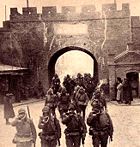
The Mukden Incident, also known as the "Manchurian Incident" or the "Far Eastern Crisis", was one of the League's major setbacks and acted as the catalyst for Japan's withdrawal from the organization. Under the terms of an agreed lease, the Japanese government had the right to station its troops in the area around the South Manchurian Railway, a major trade route between the two countries, in the Chinese region of Manchuria. In September 1931, a section of the railway lightly damaged by officers and troops of the Japanese Kwantung Army, as a pretext for an invasion of Manchuria. The Japanese army, however, claimed that Chinese soldiers had sabotaged the railway and in apparent retaliation (acting contrary to the civilian government's orders) occupied the entire region of Manchuria. They renamed the area Manchukuo, and on 9 March 1932, set up a puppet government with Pu Yi, the former emperor of China, as its executive head. Internationally, this new country was recognised only by the governments of Italy and Germany; the rest of the world still considered Manchuria legally part of China. In 1932, Japanese air and sea forces bombarded the Chinese city of Shanghai, sparking the short war of the January 28 Incident.
The League of Nations agreed to a request for help from the Chinese government, but the long voyage by ship delayed League officials from investigating the matter. When they arrived, the officials were confronted with Chinese assertions that the Japanese had invaded unlawfully, while the Japanese claimed they were acting to keep peace in the area. Despite Japan's high standing in the League, the subsequent Lytton Report declared Japan to be in the wrong and demanded Manchuria be returned to the Chinese. Before the report could be voted upon by the Assembly, Japan announced its intention to push further into China. The report passed 42-1 in the Assembly in 1933 (only Japan voted against), but instead of withdrawing its troops from China, Japan withdrew its membership from the League.
According to the Covenant of the League of Nations, the League should have responded by placing economic sanctions on Japan, or gathered an army and declared war. Neither of these actions was undertaken. The threat of economic sanctions would have been almost useless because the United States was not a League member. Any economic sanctions the League placed on its member states would have been ineffective, as a country barred from trading with other member states could simply turn and trade with the United States. The League could have assembled an army but major powers like as Britain and France were too preoccupied with their own affairs, such as keeping control of their extensive colonies, especially after the turmoil of World War I. Japan was therefore left in control of Manchuria, until the Soviet Union's Red Army took over the area and returned it to China at the end of World War II.
Chaco War
The League failed to prevent the 1932 war between Bolivia and Paraguay over the arid Gran Chaco region of South America. Although the region was sparsely populated, it contained the Paraguay River which would have given one of the two landlocked countries access to the Atlantic Ocean, and there was also speculation, later proved incorrect, that the Chaco would be a rich source of petroleum. Border skirmishes throughout the late 1920s culminated in an all-out war in 1932, when the Bolivian army attacked the Paraguayans at Fort Carlos Antonio López at Lake Pitiantuta. Paraguay appealed to the League of Nations, but the League did not take action when the Pan-American conference offered to mediate instead. The war was a disaster for both sides, causing 57,000 casualties for Bolivia, whose population was around three million, and 36,000 dead for Paraguay, whose population was approximately one million. It also brought both countries to the brink of economic disaster. By the time a ceasefire was negotiated on 12 June 1935, Paraguay had seized control over most of the region. This was recognized in a 1938 truce by which Paraguay was awarded three-quarters of the Chaco Boreal.
Italian invasion of Abyssinia
In October 1935, Italian leader Benito Mussolini sent 400,000 troops to invade Abyssinia (Ethiopia). General Pietro Badoglio led the campaign from November 1935, ordering bombing, the use of chemical weapons like mustard gas, and the poisoning of water supplies, against targets which included undefended villages and medical facilities. The modern Italian Army defeated the poorly armed Abyssinians, and captured Addis Ababa in May 1936, forcing Emperor Haile Selassie to flee.
The League of Nations condemned Italy's aggression and imposed economic sanctions in November 1935, but the sanctions were largely ineffective since they did not ban the sale of oil or close the Suez Canal (controlled by Britain). As Stanley Baldwin, the British Prime Minister, later observed, this was ultimately because no one had the military forces on hand to withstand an Italian attack. In October 1935, the American President Franklin Delano Roosevelt (a non-League member) invoked the American 1935 Neutrality Act and placed an embargo on arms and ammunition with both sides, but extended a "moral embargo" on the belligerent Italians further, including other trade items. On 5 October and later on 29 February 1936 the United States endeavoured, with uncertain success, to limit its exports of oil and other materials to normal peacetime levels. The League sanctions were lifted on 4 July 1936, but by that point Italy had already gained control of the urban areas of Abyssinia.
In December 1935, the Hoare-Laval Pact was an attempt by British Foreign Secretary, Samuel Hoare and French Prime Minister Pierre Laval to end the conflict in Abyssinia by drawing up a plan to partition the country into two parts: an Italian sector and an Abyssinian sector. Mussolini was prepared to agree to the Pact; however, news of the Pact was leaked and both the British and French public venomously protested against it, describing it as a sell-out of Abyssinia. Hoare and Laval were forced to resign their positions, and both the British and French governments disassociated from them. In June 1936, although there was no precedent for a head of state addressing the Assembly of the League of Nations in person, the Emperor of Ethiopia Haile Selassie I spoke to the Assembly to appeal for its help in protecting his country.
As was the case with Japan, the vigour of the major powers in responding to the crisis in Abyssinia was tempered by their perception that the fate of this poor and far-off country, inhabited by non-Europeans, was not a central interest of theirs. In addition, it showed how the League could be influenced by the self-interest of its members; one of the reasons why the sanctions were not very harsh was that both Britain and France feared the prospect of driving Mussolini and Adolf Hitler into an alliance.
Spanish Civil War
On 17 July 1936, the Spanish Army launched a coup d'état leading to a prolonged armed conflict between Spanish Republicans (the leftist government of Spain) and the Nationalists, conservative, anti-communist rebels who included most officers of the Spanish Army. Alvarez del Vayo, the Spanish Minister of Foreign Affairs, appealed to the League in September 1936 for arms to defend its territorial integrity and political independence. The League members, however, would not intervene in the Spanish Civil War nor prevent foreign intervention in the conflict. Hitler and Mussolini continued to aid General Franco’s Nationalist insurrectionists, and the Soviet Union aided the Spanish loyalists. In February 1937, the League did launch a ban on the intervention of foreign national volunteers.
Disarmament and failures en route to World War II
Article eight of the League's covenant gave the League the task of reducing "armaments to the lowest point consistent with national safety and the enforcement by common action of international obligations" A significant amount of the League's time and energy was devoted to disarmament even though many member governments were uncertain that such extensive disarmament could be achieved or was even desirable. The Allied Powers were also under obligation from the Treaty of Versailles to attempt to disarm and the armament restrictions imposed on the defeated countries had been described as the first step toward world wide disarmament. The League Covenant assigned the League the task of creating a disarmament plan for each state but the Council devolved this responsibility to a special commission set-up in 1926 to prepare for the 1932-34 World Disarmament Conference. Members of the League held different views towards disarmament. The French were reluctant to reduce their armaments without a guaruntee of military help if they were attacked, Poland and Czecholslovakia felt vulnerable to attack from the east and wanted the League's response to aggression against its members to be strengthened before they disarmed.
The Disarmament Commission obtained initial agreement from France, Italy, Japan, and Britain to limit the size of their navies. The Kellogg-Briand Pact, facilitated by the commission in 1928, failed in its objective of outlawing war. Ultimately, the Commission failed to halt the military build-up by Germany, Italy and Japan during the 1930s. The League mostly silent in the face of major events leading to World War II such as Hitler's remilitarisation of the Rhineland, occupation of the Sudetenland and Anschluss of Austria, which had been forbidden by the Treaty of Versailles. In fact, League members themselves re-armed. In 1933, Japan simply withdrew from the League rather than submit to its judgement, as did Germany in 1933 (using the failure of the World Disarmament Conference to agree to arms parity between France and Germany as a pretext), and Italy in 1937. The League commissioner in Danzig was unable to deal with German claims on the city, a significant contributing factor in the outbreak of World War II in 1939. The final significant act of the League was to expel the Soviet Union in December 1939 after it invaded Finland.
General weaknesses
The onset of the Second World War suggested that the League had failed in its primary purpose, which was to avoid any future world war. There were a variety of reasons for this failure, many connected to general weaknesses within the organisation.
Origins and structure
The origins of the League as an organisation created by the Allied Powers as part of the peace settlement at the end of the first world war led to it being viewed as a "League of Victors". It also tied the League to the Treaty of Versailles so that when the Treaty became discredited and unpopular, this reflected on the League of Nations.
The League's supposed neutrality tended to manifest itself as indecision. The League required a unanimous vote of its nine, later fifteen, member Council to enact a resolution; conclusive and effective action was difficult, if not impossible. It was also slow in coming to its decisions as certain decisions required unanimous consent of the entire Assembly.
Global representation
Representation at the League was often a problem. Though it was intended to encompass all nations, many never joined, or their time as part of the League was short. Most notably missing was the position that the United States of America was supposed to play in the League, not only in terms of helping to ensure world peace and security but also in financing the League. The U.S. President Woodrow Wilson had been a driving force behind the League's formation and strongly influenced the form it took but the United States Senate voted not to join on 19 November 1919. Ruth Henig has suggest that, had the United States been a member of the League, it would have also provided backup to France and Britain, possibly making France feel more secure and so encouraging France and Britain to co-operate more regarding Germany and so made the rise to power of the Nazi party less likely. On the contrary, Henig acknowledges that if America had been a member of the League, its reluctance to engage in war with European states and to enact economic sanctions may have hampered the ability of the League to deal with international incidents. The structure of government in America may also have made its membership problematic as its representatives at the League could not have made decisions on behalf of the United States executive branch without this having already been approved by the legislative branches.
In January 1920, when the League began, Germany was not permitted to join because it was seen as the aggressor in World War I. Soviet Russia was also initially excluded from the League, as communist views were not welcomed by the victors of World War I. The League was further weakened when critical powers left in the 1930s. Japan began as a permanent member of the Council, but withdrew in 1933 after the League voiced opposition to its invasion of the Chinese territory of Manchuria. Italy also began as a permanent member of the Council but withdrew in 1937. The League had accepted Germany as a member in 1926, deeming it a "peace-loving country", but Adolf Hitler pulled Germany out when he came to power in 1933.
Collective security
Another important weakness grew from the contradiction between the idea of collective security, that formed the basis of the League, and international relations between individual states. The collective security system the League used meant that nations were required to act against states they considered friends, and in a way that might endanger their national interests, to support states that they had no normal affinity with. This weakness was exposed during the Abyssinia Crisis when Britain and France had to balance attempts to maintain the security they had attempted to create for themselves in Europe "in order to defend against the enemies of internal order", in which Italy's support played a pivotal role, with their obligations to Abyssinia as a member of the League.
On 23 June 1936, in the wake of the collapse of League efforts to restrain Italy's war of conquest against Abyssinia, British Prime Minister Stanley Baldwin told the House of Commons that collective security had
"failed ultimately because of the reluctance of nearly all the nations in Europe to proceed to what I might call military sanctions ... [T]he real reason, or the main reason, was that we discovered in the process of weeks that there was no country except the aggressor country which was ready for war ... [I]f collective action is to be a reality and not merely a thing to be talked about, it means not only that every country is to be ready for war; but must be ready to go to war at once. That is a terrible thing, but it is an essential part of collective security."
Ultimately, Britain and France both abandoned the concept of collective security in favour of appeasement in the face of growing German militarism under Adolf Hitler.
Pacifism and disarmament
The League United Nations, lacked an armed force of its own and depended on the Great Powers to enforce its resolutions, which they were very reluctant to do. The League's two most important members, Britain and France, were reluctant to use sanctions and even more reluctant to resort to military action on behalf of the League. Immediately after World War I, pacifism was a strong force both in the populations and the governments of the two countries. The British Conservatives were especially tepid on the League and preferred, when in government, to negotiate treaties without the involvement of the organization.
Moreover, the League's advocacy of disarmament for Britain, France and its other members whilst at the same time advocating collective security meant that the League was unwittingly depriving itself of the only forceful means by which its authority would be upheld. If the League was to force countries to abide by international law, it would require the Royal Navy and the French Army to do the enforcing.
When the British Cabinet discussed the concept of the League during the First World War, Maurice Hankey, the Cabinet Secretary, circulated a memorandum on the subject. He started by saying: "Generally it appears to me that any such scheme is dangerous to us, because it will create a sense of security which is wholly fictitious". He attacked the British pre-war faith in the sanctity of treaties as delusional and concluded by claiming:
"It [a League of Nations] will only result in failure and the longer that failure is postponed the more certain it is that this country will have been lulled to sleep. It will put a very strong lever into the hands of the well-meaning idealists who are to be found in almost every Government, who deprecate expenditure on armaments, and, in the course of time, it will almost certainly result in this country being caught at a disadvantage".
The Foreign Office minister Sir Eyre Crowe also wrote a memorandum to the British Cabinet claiming that "a solemn league and covenant" would just be "a treaty, like other treaties": "What is there to ensure that it will not, like other treaties, be broken?". Crowe went on to express scepticism of the planned "pledge of common action" against aggressors because he believed the actions of individual states would still be determined by national interests and the balance of power. He also criticised the proposal for League economic sanctions because it would ineffectual and that "It is all a question of real military preponderance". Universal disarmament was a practical impossibility, Crowe warned.
Demise and legacy
As the situation in Europe deteriorated into war, the Assembly transferred enough power to the Secretary General on 30 September 1938 and 14 December 1939 to allow the League to continue to legally exist and to carry on reduced operations. The headquarters of the League, the Palace of Peace, remained unoccupied for nearly six years until the Second World War ended.
The final meeting of the League of Nations was held in April 1946 in Geneva. Delegates from 43 nations attended the assembly. This session concerned itself with liquidating the League: assets worth approximately $22,000,000 in 1946, including the Palace of Peace and the League's archives, were given to the UN, reserve funds were returned to the nations that had supplied them, and the debts of the League were settled. Robert Cecil is said to have summed up the feeling of the gathering during a speech to the final assembly when he said:
Let us boldly state that aggression wherever it occurs and however it may be defended, is an international crime, that it is the duty of every peace-loving state to resent it and employ whatever force is necessary to crush it, that the machinery of the Charter, no less than the machinery of the Covenant, is sufficient for this purpose if properly used, and that every well-disposed citizen of every state should be ready to undergo any sacrifice in order to maintain peace ... I venture to impress upon my hearers that the great work of peace is resting not only on the narrow interests of our own nations, but even more on those great principles of right and wrong which nations, like individuals, depend.
The League is dead. Long live the United Nations
The motion that dissolved the League passed unanimously: "The League of Nations shall cease to exist except for the purpose of the liquidation of its affairs." The motion also set the date for the end of the League as the day after the session was closed. On 19 April 1946, the President of the Assembly, Carl J. Hambro of Norway, declared "the twenty-first and last session of the General Assembly of the League of Nations closed." As a result, the League of Nations ceased to exist on 20 April 1946.
Professor David Kennedy, has suggested that the League is a unique moment when international affairs were "institutionalized" as opposed to the pre-World War I methods of law and politics.
At the 1943 Tehran Conference, the Allied Powers agreed to create a new body to replace the League: the United Nations. Many League bodies, such as the International Labour Organization, continued to function and eventually became affiliated with the UN. The structure of the United Nations was intended to make it more effective than the League. The principal Allies in World War II (the UK, the USSR, France, the U.S., and China) became permanent members of the UN Security Council; these new "Great Powers" gained significant international influence, mirroring the League Council. Decisions of the UN Security Council are binding on all members of the UN; however, unanimous decisions are not required, unlike the League Council. Permanent members of the UN Security Council are also given a shield to protect their vital interests, which has prevented the UN acting decisively in many cases.
Similarly, the UN does not have its own standing armed forces, but the UN has been more successful than the League in calling for its members to contribute to armed interventions, such as during the Korean War and the peacekeeping mission in the former Yugoslavia. The UN has in some cases been forced to rely on economic sanctions. The UN has also been more successful than the League in attracting members from the nations of the world, making it more representative.

